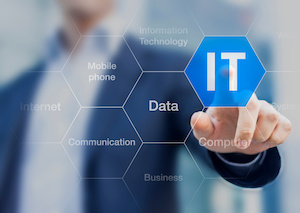 Working in the office may look different than it did pre-pandemic. From office arrangements to how meetings take place are all changes you may now see as the “new normal,” but what about the IT security in your office? Protecting important information/data requires countless risk management actions so making sure security is addressed is essential. The importance of IT security should always be on the forefront of business protocol.
Working in the office may look different than it did pre-pandemic. From office arrangements to how meetings take place are all changes you may now see as the “new normal,” but what about the IT security in your office? Protecting important information/data requires countless risk management actions so making sure security is addressed is essential. The importance of IT security should always be on the forefront of business protocol.
Addressing IT (Information Technology) Security Challenges
Information technology involves the use of computers (including hardware and software) to access, process, store, and retrieve data. Typically, there is a group of specialized IT workers whose job is to trouble shoot the many challenges of properly securing valuable information and electronic data; however, sometimes there are challenges that can occur that can disrupt the security and must be addressed immediately.
Ways to Minimize Malicious Malware and Optimize Protection of Electronic Data
Malicious malware is software designed to infect systems and networks as a way to gain access to valuable information. Hackers use many methods to infect computer systems which is why IT must stay focused on addressing ways to optimize protection of sensitive information/data while minimizing the likelihood of malware attacks. Below are ways to do this.
Application Control- Many cyberattacks aren’t as obvious as others, so finding ways to prevent data breaches when the attack is more indirect is essential. Application control is used to recognize traffic from various applications on a network and stop any unauthorized programs from posing a risk to the business. By limiting which files can be downloaded, open, or run, you are minimizing the likelihood of malicious programs being executed.
Secure Microsoft Office Macros- Businesses should set controls under the Microsoft office macro settings to only allow macros from trusted and reliable sources; otherwise, you could be faced with a major threat to your security. Determining which macros are trusted and which pose a threat is essential. Below are three ways to do this:
- Determine if the macro is linked to a reliable business necessity.
- Determine if the macro was established by a reliable source and has not been altered.
- Study the macro to verify it does not contain malicious code and that it performs as expected.
Patch Management- Always make sure to use the most recent operating system version of the software. Even with doing this, sometimes errors are noticed, therefore, patch management is designed to “patch” and fix any “bugs” or issues to ensure a secure environment.
Application Hardening- Application hardening is important because it prevents hackers’ efforts to tamper with an application and ensures that the app is operating in a secure environment. Certain apps are known to have malicious code on systems such as Java and Flash so this will block those types of ads as a means of security.
Daily Software Backups– Backing up your software, data, and valuable information daily is a way to help minimize the risk of a malware attack. You need to make sure if your security is compromised, you have a way to retrieve data that was accessed.
Multi-factor Authentication- Hackers invest a lot of time to access systems and steal sensitive information so it’s imperative to use a multi-factor authentication when you are opening important or highly sensitive data. It also should be necessary for remote access locations, RDP (Remote Desktop Protocol), and VPNs (Virtual Private Network).
Cameron Insurance Group is Here for all for Your New York Business Needs
IT plays a vital role in today’s business world and should always remain a priority to ensure all highly sensitive data is secure. If you have any questions or concerns about IT security in your business, call our offices at Cameron Insurance Group and we will assist you. We are here for all your New York commercial needs. Don’t wait. Call today at 845-627-2130.






Leave A Comment